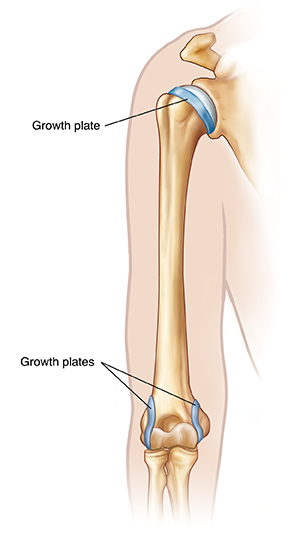When Your Child Has Little Leaguer’s Elbow or Little Leaguer’s Shoulder
Your child has been diagnosed with little leaguer’s elbow or shoulder. Little leaguer’s elbow or shoulder is caused by overuse of the arm. This condition is an irritation of the growth plates in the elbow or shoulder. A growth plate is the soft part of a bone that lets the bone grow as the child grows. Little leaguer’s elbow or shoulder is most common among children who play sports, especially baseball. Because a child is still growing and developing, the demands of a sport on the child’s body can be too much. This is especially true if the child isn’t given enough rest time between active sessions. Little leaguer’s elbow or shoulder is a painful condition. But it can be treated with proper care.

What causes little leaguer’s elbow or shoulder?
Little leaguer’s elbow or shoulder is caused by too much overhead movement of the arm, such as pitching a baseball. Overhead movement causes the muscles in the arm to pull on the growth plates. When this movement is repeated over and over, the space in the growth plates begins to widen. In some cases, the growth plates pull away from the bone.
What are the symptoms of little leaguer’s elbow or shoulder?
-
Pain or “heaviness” in the arm while throwing
-
Elbow or shoulder pain, especially after throwing
-
Tightness of the elbow or shoulder, causing decreased range of motion (inability to fully extend the elbow or rotate the shoulder) or weakness
How is little leaguer’s elbow or shoulder diagnosed?
The healthcare provider will ask about your child’s health history and examine your child. They will check your child’s elbow or shoulder for soreness, range of motion, and pain. An X-ray and possibly an MRI may also be done. These tests take images of the inside of the body. They help the provider diagnose the injury.
How is little leaguer’s elbow or shoulder treated?
The healthcare provider will talk with you about the best treatment plan for your child. As instructed, your child will:
-
Rest from pitching or throwing for about 6 weeks or more.
-
Ice the elbow or shoulder 3 to 4 times a day for 15 to 20 minutes at a time. To make an ice pack, put ice cubes in a plastic bag that seals at the top. Wrap the bag in a clean, thin towel or cloth. Never put ice or an ice pack directly on the skin.
-
Take anti-inflammatory medicine, such as ibuprofen, as directed.
-
Learn or practice throwing methods that are less likely to cause injury.
-
Decrease the amount of activity done with the elbow or shoulder. For example, if your child is a pitcher, the healthcare provider may limit the number of pitches your child should throw.
-
Do exercises as instructed by the provider. Your child may be referred to a physical therapist for a supervised program of exercises. Your child’s physical therapist or healthcare provider may also ask your child to do exercises at home.
What are the long-term concerns?
If your child’s condition isn’t cared for, they may have trouble using the elbow or shoulder in the future. Left untreated, the condition can lead to lasting (permanent) damage of the growth plates.
Prevention
Little leaguer’s elbow and shoulder have become more common as children’s sports have become more competitive. But this painful health problem can be prevented. To help prevent it:
-
Don’t allow your child to throw every day. Be sure they get days off from throwing.
-
Discuss your child’s training and game schedule with their coach and healthcare provider. Pitches or throws should be counted to ensure that your child is not throwing too many times in any game or practice. Talk with the coach about pitch count limits and make sure your child is not going over this limit.
-
Never let your child play or practice if they are hurt.
-
Limit your child’s throwing activities to no more than 9 months out of the year. For at least 3 months each year, your child should not play throwing sports (like baseball) and should only do nonthrowing activities. This rest period gives the body time to repair itself.
Online Medical Reviewer:
L Renee Watson MSN RN
Online Medical Reviewer:
Raymond Turley Jr PA-C
Online Medical Reviewer:
Thomas N Joseph MD
Date Last Reviewed:
12/1/2021
© 2000-2024 The StayWell Company, LLC. All rights reserved. This information is not intended as a substitute for professional medical care. Always follow your healthcare professional's instructions.